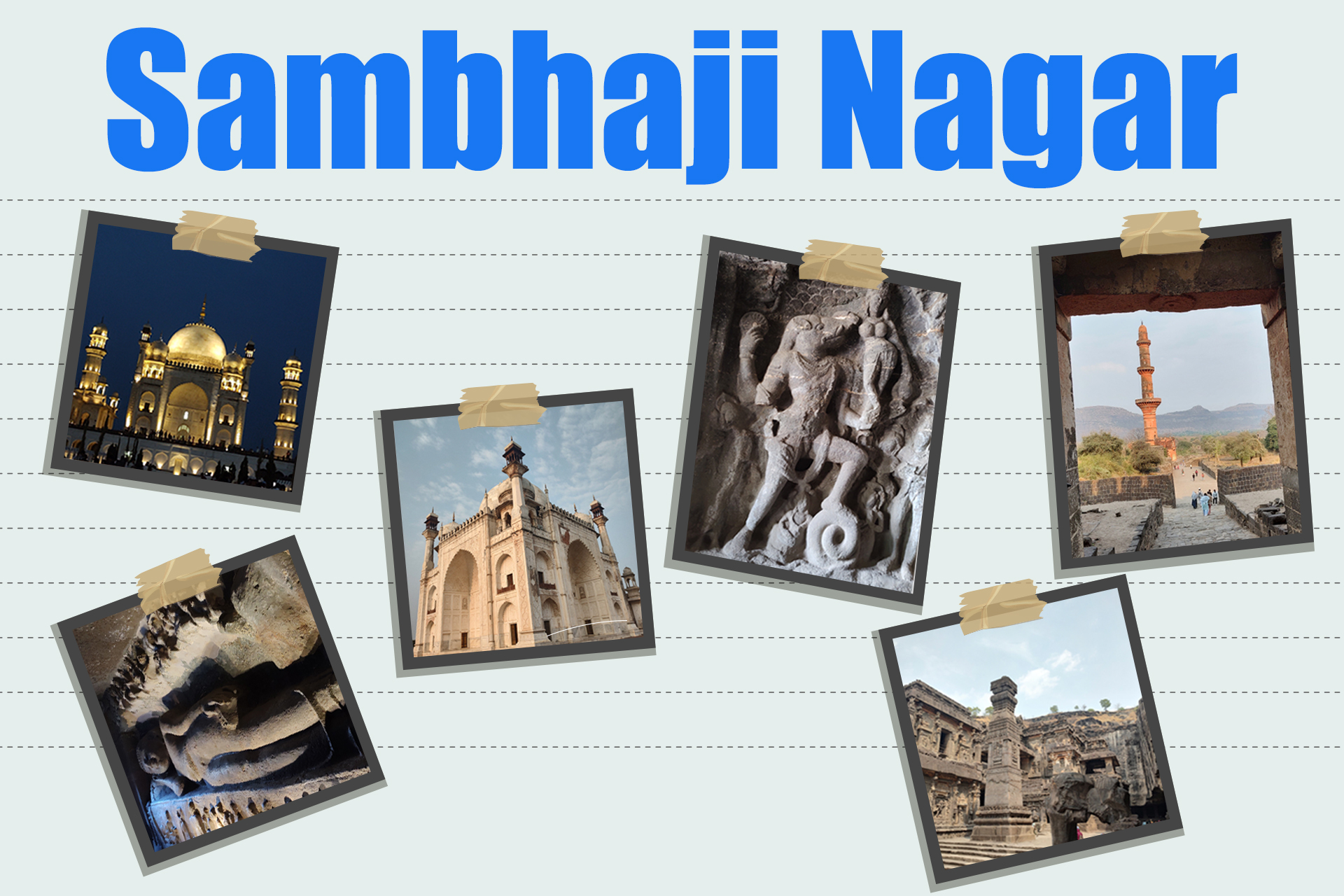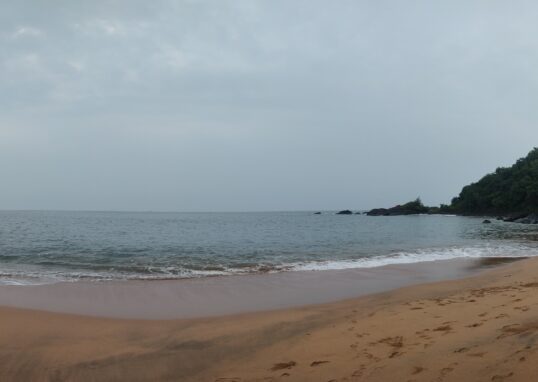Chhatrapati Sambhaji Nagar

A largest city of Marathwada region from Maharashtra. A city with many heritage sites and historical monuments which includes ajintha caves, bibi ka maqbara etc. Chhatrapati sambhaji nagar is also known as “City of Gates”, due the 52 historical gates the city have. The city have Delhi gate in north, Jalna gate in east, paithan gate in south and mecca gate in west. Out of 52 gates Bhadkal gate is eldest, famous, and biggest gate; which was built by malik ambar as a symbol of his victory over Mughals. Along with these gates makai gate, kala Darwaja, rangeen Darwaja are also equally famous.
What you can explore
Ajanta Caves
Ajanta caves is declared as a UNESCO world heritage site, and is a masterpiece of art and rock cut architecture, carvings, and paintings.
There are many worship halls(chaitya) and monesteries(vihara) dedicated to lord buddha. Many generations show their skills and art in 4 decades to create this masterpiece, which built in 2 phases. 1st phase was in 2nd century of BCE(Before Common Era)(under Hindu satavahana dynasty), and 2nd phase in 400 to 650 CE(Common Era)(Maurya and gupta empire). Paintings were mainly done in 2nd phase. There is total 29 caves carved in these 2 phases. These caves are built over Waghur river in “U” shape, which depicts the stories of birth, stories of nagaraja, birth stories of swan etc. Some caves are refurbished in 2nd phase and some caves are incomplete. Every cave have a doorkeeper carved at the entrance of the cave.
There are total 29 caves out of them you can explore and experience 26 caves only. Many caves have their own names. Paintings of these caves are today known as portraits and 3D paintings, which were painted in 600th century.
The main identity and attraction is buddhishtava Padmapani, easily visible in cave no. 1 which have 20 beautifully carved pillars.
4th cave is the largest cave here, which have 28 beautiful and magnificently carved pillars. Few are 2 storied caves.
Cave no. 10 is a Hinayan Buddhist temple. This cave have around 40 carved pillars and stupa with buddha’s statue. Many caves have many paintings which depicts buddha’s life. The entrance of cave no. 16 is so beautiful and mesmerizing.
Cave no. 26 have 28 feet huge sleeping buddha(mahaparinirvan pose) carved at the left side of the entrance along with many buddhist lords. Last 2 caves are ruined and no proper route to reach there. Many buddhist monks come here for worship, they sit here and chant buddha’s name.
Ajanta caves are accidently discovered by british officer capt. John smith on his tiger hunting safari. Before him caves were well known by local people. He went to nearby village and call locals to cut the tangled jungle to enter in the cave. Later he writes his name and date by scratching the painting of a bodhisattva. Later on in a decade caves become very famous due to it’s impressive architecture and unique paintings. Wall paintings here predominantly narrate the previous birth stories of buddha.
Ellora caves(Verul Caves)
It is combination of biddhist, hindu and jain culture. Out of 34 caves first 12 caves belong to biddhist culture. Cave no 13-29 dedicated to hindu/ bramhani culture. And rest belongs to adoration of jain culture.
Many caves were used as worship halls and few are used as stays for monks who came from different part of the world.
These caves were built close to each other and represents the religious harmony that existed in india. Because of the exceptional architecture of ancient india, Ellora caves are listed as UNESCO’s world heritage in 1983.
Ellora name came from elapura which was the capital of rashtrakuta empire. The ellora caves are famous all over the world as the best sight of Indian sculpture. these caves stands apart in a map of world with their own identity and stories.
Many caves have a sculpture of meditating buddha carved with doormen at the entrance. Many caves are 2 or 3 storied.
Sculpture of Sarasvati(refered as mahamayuri in buddhism) carved in cave no. 6 along with other buddhist god goddess. Goddess ganga-yamuna are also carved at the entrance of this cave.
Cave no. 10 is believed that the last worship hall at that time. It is a 2 storied cave. You can see a detailed and beautiful carving at the rooftop at 2nd floor. At 1st floor there is a buddha sculpture available in front of stupa which is so attractive. And the sound echoed in this worship hall. Kuber, lord Ganesha, and meditative buddha are carved in next 2 caves, which are 2 and 3 storied caves.
In many hindu cultured caves you can lord shankara in different forms such as calm, Nataraj, an aggressive form who is fighting with demons.
You can see a huge nandi in front of lord shankar and goddess Parvati at cave no. 14. At many places you can observe some moments carved from the wedding of lord shankar and goddess Parvati.
In some caves lord ganesh, gajalakshmi, kartikeya, bramha, Vishnu, maheshand many more god and goddess are carved. Especially varah form of lord Vishnu is so attractive.
Cave no 16. Kailasa temple. Which is itself a magnificent work of art. I can write a whole separate blog on this cave. It is that much mesmerizing.
Ellora caves are carved in a single mountain, but kailasa temple is a cave which is carved in a single rock; starting from top and end at the base. The rough area of kailasa temple is around 150*110 feet, and 110 feet in height. It is a single rock cut temple which is dedicated to kailasa mountain from himalaya. It Is a well-planned cave. Initially a big pit was dug and moat was made. Later artists start to carve from top to bottom.
It replicates the dravid architecture of Karnataka state. It takes around 150-200 years of 6-7 generations to create this wonder. Here you can see Vishnu, shiv puran, Ramayana, Mahabharata are carved on temples wall. A huge Shivalinga along with nandi is there on 1st floor. The worship hall have 16 beautifully carved pillars and some god structure is carved at the roof top. Behind this a lord ganesha’s temple is there along with some more gods carved. The outside of this hall at ground 1 whole column is carved with 2 giant elephants. Temple walls are carved with some moments from Ramayana, Mahabharata, childhood stories of lord krishna, 10 forms of lords Vishnu, goddess ganga, Yamuna, Sarasvati, and many more things are carved. One of the carved column and elephant is printed on Indian 20/- note; it is this much prestigious for ourselves.
You can hardly see any monument which is carved in a large stone with such planning, and that’s why it is known as “wonder of the world in rock monument!”
In remaining hindu caves you can see a tri-murti of bramha-vishnu-mahesh, mahishasumardini, Balaram, krishna.
Cave no. 28 is known as “dharatirtha cave” because it lies under a waterfall, which give you a mesmerizing view in monsoon. In jain caves lord Mahavir and other gods you can see. Cave no. 32 is a 3 storied cave. 1st floor is of temple, 2nd floor is known as “Indrasabha” where you can see goddess Matanga seated on elephant. A lotus is carved on roof top. It is also known as mini kailasa temple.
Ghrishneshwar Temple
It is one of the 12 jyotirlingas. I visited in a morning time, so it was less crowded. Here men have to enter with bare body. It is a reconstructed temple originally from 10th century. It is situated at half kms away from ellora caves.
Daulatabad/ Devgiri fort
Daulatabad/ Devgiri fort is situated at daulatabad village of sambhaju nagar. It was a capital of yadavas in 9th century, a capital of delhi sultanate in 13th century, and later on 2nd capital of ahmadnagar sultanate in 14th century.
The fort is situated on a 200 mtrs high hill. Fort’s walls are in well condition. You can see the whole city from the top of the fort. Devgiri fort is so secured that all dynasties who ruled here made it their capital.
You can see a temple inside a fort which is known as bharat mata temple. This temple have a goddess status which is in standing position. This temple have a huge open space in front of the temple. Even it have a area where lots of pillars are constructed and are in good condition. Inside the for you can also see a Charminar.
Few watch view towers are also in good condition. On this fort you can see few cannons, out of them mendha cannon is popular. It is named because of it’s face is made like a sheep. You have to pass a bridge to enter in a main fort. This bridge was made over a moat, which was filled by water and crocodiles at that time. Devgiri fort have only one entry-exit point, so if this bridge collapse then it is difficult for enemies to capture this fort. And by any chance enemy succeeded to pass this bridge then there is a confusing route which brings to the top side know as “Andheri”. It have some hidden places to hide and attack on enemy.
It is believed that, when Chhatrapati Shivaji maharaj visited devgiri fort before going to agra, he made a statement which is “This for is so strong and difficult to capture; but fort have a minus point and that is this fort don’t have a second entry/exit point. When enemy enters in main fort we need an another route to execute alternate strategy.”
Bhadra Maruti mandir and handloom factories
Bhadra Maruti mandir is located at khultabad region of sambhaji nagar. The mandir is dedicated to lord hanuman. The mandir was destroyed by Mughals when they won this region. But some people saved the statue for years, and in 1960 the mandir was reconstructed. Nowadays it is made up of marble stones. It is out of 3 places where hanuman is in sleeping pose. Also on this route, you can easily find handloom factories where you can purchase the handmade silk sarees and dress pieces for women. Also you can watch the process of making such sarees and dress pieces.
Bibi ka maqbara
Bibi ka maqbara is AKA Tomb of lady or taj of deccan. It is built by son of Aurangzeb prince azam shah in fond memory of his mother Dilras banu begum in 1660.Azam shah decied to make a replica of taj mahal which was mausoleum of aurangazeb’s mother Mumtaz hence Aurangzeb was not much interested to built such structure, so he sanctioned a small budget. Azam shah appointed descedent’s of makers of taj mahal. One can easily see a beauty of maqbara in evening time, when the lights add beauty to the view. Maqbara have a tomb of dilras banu begum. The marbles of maqbara are in floral patterns, and decorative art work. Maqbara have a formal garden and pool in front of it. You can visit any time but the evening time will adds a little beauty to the view which needs to be witnessed.
Author
velkar.suryakant@gmail.com
